Abstract
Embedded sensor technologies have emerged as pivotal tools in redefining structural health monitoring (SHM) within composite materials, addressing a critical need in the composite structure industry. Composites, by their layered nature, are particularly vulnerable to internal delamination and micro-cracks from impacts, which can propagate and lead to catastrophic failures. Traditional inspection methods often fail to detect internal damage and these undetected damages can lead to reduced performance and potential system failures. Embedded sensors offer a solution capable of detecting a spectrum of damages, from barely visible impact damages (BVID) and subtle low-energy impacts to pronounced impact-related deformations, all in real-time. Key sensors, such as Piezoelectric transducers (PZTs), Fiber Bragg Gratings (FBGs), and other potential sensors, have been discussed as potential detection techniques in this review. This review discusses a comprehensive picture of the progress and current scenario of different embedded sensors for SHM of composite structures. The growth of embedded sensor technologies, current limitations, and future requirements focusing on sensor materials have been discussed in this review. Finally, challenges and opportunities for the development of a sustainable SHM system have been discussed in this paper.
1. Introduction
Composite materials have firmly established themselves as key components in aerospace, automotive, and civil engineering due to their exceptional strength, lightweight properties, and adaptability [1]. However, their structural composition, which combines matrix and reinforcing constituents (fibers), is vulnerable to internal impairments, particularly from impact forces [2]. Often invisible to the naked eye, these impairments can compromise the material’s structural integrity, highlighting the importance of timely and accurate detection [3].
SHM emerges as a critical discipline focused on enhancing the sustainability of composite structures. It uses a spectrum of techniques and technologies designed to continuously monitor the response of structures to external effects and detect and locate damages [4]. Traditional methods such as visual inspections have been the mainstay for years, offering a straightforward way to identify obvious surface damages [5]. More advanced techniques such as the ultrasonic C-scan, which utilizes ultrasonic waves, have expanded the capacity to detect subsurface defects [6]. However, even with these advancements, there remains a need for more intrinsic, real-time monitoring solutions. This is where embedded sensors have carved a significant niche [7]. Embedded sensors, seamlessly integrated within the composite material’s structure, distinguish themselves by offering several advantages over their surface-mounted counterparts. Their embedded placement allows them to detect even the minutest variations or damage that may elude external sensors [8]. Moreover, their proximity to potential sources of damage enables continuous, uninterrupted monitoring without the need for periodic manual inspections. In aerospace applications where aerodynamic efficiency reigns supreme, integrating embedded sensors preserves the surface profile integrity, thereby circumventing any aerodynamic penalties [9]. Furthermore, their placement inside the material shelters them from environmental factors, which can be detrimental to surface-attached sensors, thus potentially increasing their operational lifespan. Another salient feature is their heightened sensitivity and accuracy, stemming from their intimate contact with the inner layers of the composite, which ensures a more nuanced and accurate damage assessment.
However, the process of embedding sensors in composite materials comes with its own set of challenges. Factors such as the choice of sensor, its strategic positioning within the composite, compatibility with the material’s constituents, and resilience under various operational conditions require careful consideration [10].
This review aims to delve into embedded sensor technologies, particularly within the context of SHM for composite materials. We will explore the operational principles, advantages, integration challenges, and innovative solutions being developed. By painting a comprehensive picture of the present scenario and potential future of embedded sensors in SHM for composites, we aim to offer a resource that both researchers and industry professionals will find indispensable. This review emphasizes embedded sensors in thermoset composites. Although the rise of sensors in thermoplastic composites is evident and noteworthy, the discourse remains centered on thermoset materials to ensure depth and clarity.
2. Impact Events on Composites
With all their inherent advantages, composites display distinct vulnerabilities when exposed to dynamic impact loads. Such impacts can range in energy and velocity, each posing unique challenges to the durability of the composites and making a comprehensive understanding of these impacts essential for effective SHM [3].
Initially, it is essential to categorize the types of impacts. Low-velocity impacts, typically 1 to 10 m/s, can result from scenarios such as tool drops, accidental bumps, or debris strikes [11]. Though seemingly benign, these impacts can impart energies of up to 15 joules, depending on the striking object’s mass [12]. In contrast, high-velocity impacts, which can exceed speeds of 150 m/s, represent more catastrophic events, such as ballistic impacts or bird strikes in aviation. These can introduce energies of well over 1000 joules [13], leading to significant damage to the structure, as seen in Figure 1.
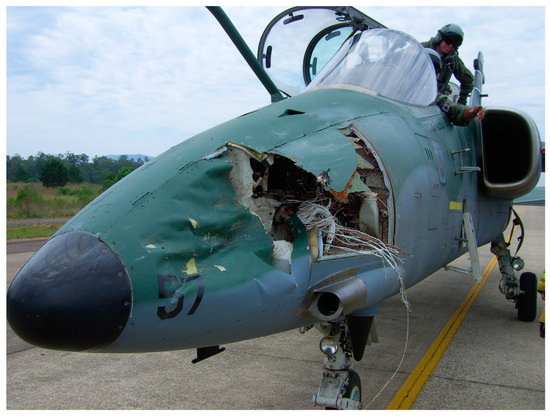
Figure 1.
Bird Strike on an AMX aircraft—Brazilian Air Force [14]. Public Domain.
One particularly insidious consequence of impacts, especially from low-velocity events, is barely visible impact damage (BVID). Although the surface might show minimal distress, the composite may suffer from internal delamination, matrix cracking, and fiber breakage. Such damage, if undetected, can evolve under sustained loading, eventually leading to a significant structural failure [4]. Repeated, low-energy impacts also pose challenges. A single impact at 2 m/s might not induce discernible damage, but cumulative impacts at this speed can degrade the composite’s structural properties over time, emphasizing the need for continuous monitoring [15,16,17,18,19].
Due to their intrinsic positioning within the composite, embedded sensors are aptly suited to detect and monitor these impacts’ aftereffects. They can capture the immediate response of the material to an impact event, even if the energy is as low as 5 joules, offering insights into the composite’s energy absorption, damage propagation, and potential zones of concern [7,8]. This capability becomes particularly vital in scenarios involving BVID, where surface-level inspections might be inadequate [4].
The financial repercussions of impacts on composite structures are profound in the aerospace industry. Aircraft downtime due to maintenance and repair after impact events can lead to significant operational costs, often reaching several thousands of USD per hour. Furthermore, undetected, or improperly addressed damage can compromise aircraft performance, leading to increased fuel consumption and, in extreme cases, necessitating early component replacements. The costs of such replacements, especially for critical structural components, can run into millions. Additionally, the intangible yet equally consequential cost is associated with potential reductions in consumer trust and brand value in the event of repeated issues or catastrophic failures. As the aerospace sector operates on thin margins, ensuring timely detection and mitigation of impact damages on composites is not merely a matter of safety but also a critical financial imperative. In 2022, wildlife collisions were forecasted to cause 67,848 h of aircraft inactivity in the US civil aviation sector, resulting in financial losses of USD 385 million [20].
As industries prioritize lightweight, robust, and adaptive materials, particularly in sectors where safety is non-negotiable, comprehending the nuances of impacts on composites becomes pivotal. Embedded sensors are invaluable allies in this quest, marrying real-time monitoring with anticipatory interventions.
3. Embedded Sensor Technologies and Applications
Embedded sensors integrate within composite materials during fabrication, ensuring intimate contact with the material’s layers without compromising structural characteristics. Precise positioning within the composite not only affects the ability of these sensors to detect impacts but also determines the type of information relayed.
Piezoelectric transducers (PZTs) and Fiber Bragg Gratings (FBGs) stand out among suitable sensors for embedded applications. PZTs, constructed from materials generating an electrical charge in response to mechanical stress, excel in detecting sudden strain changes, making them invaluable for real-time impact detection. Conversely, FBGs utilize optical reflection principles to detect subtle structural changes, including those induced by impacts.
The placement of these sensors within the composite varies based on specific monitoring requirements. Some sensors are integrated at the mid-section on all axes of the composite, providing a central vantage point for detecting internal deformations or damage. This mid-section positioning proves particularly effective for monitoring delamination or matrix cracks developing deep within the material.
Other sensors are positioned closer to the surface, enabling prompt detection of surface-level impacts or abrasions. Such placement becomes crucial for applications where external forces or debris interactions remain a primary concern, ensuring immediate detection and assessment. Finally, the sensors can be embedded closer to the composite’s back or innermost layer, strategically positioned to monitor damages or deformations propagating from the rear, especially in scenarios where the composite faces exposure to impacts or stresses from both sides.
Embedded sensors generate a wealth of data that are crucial for understanding the structural health of composite materials. Analytical models play a key role in interpreting these data, transforming sensor readings into detailed insights about the material’s condition. These models employ advanced signal processing techniques to decode the electrical charges from PZTs and the wavelength shifts from FBGs, providing precise information on the nature and location of structural changes. This analytical approach allows engineers to make informed decisions about maintenance and repair, ensuring that interventions are both timely and effective. By continuously monitoring and analyzing sensor data, these models help maintain the integrity of structures and enhance their operational lifespan, making them invaluable in sectors where material failure poses significant risks.
3.1. Piezoelectric Sensors
Embedded piezoelectric sensors are rapidly emerging as pivotal instruments in SHM, especially in the realm of impact detection within composite materials. Drawing upon the foundational principles outlined by Pierre and Curie in 1880, these sensors leverage the direct piezoelectric effect. This phenomenon sees specific crystalline structures producing an electric charge when subjected to mechanical stress, as seen in Figure 2.
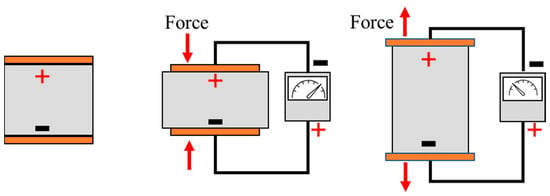
Figure 2.
Simple illustration of the piezoelectric principle.
Within the complex architecture of composite matrices, subtle or pronounced impacts initiate stress waves that radiate throughout the material. As these waves intersect with the domain of an embedded piezoelectric element, the consequential mechanical disturbance gives rise to a distinct electrical response. By meticulously analyzing this electrical signature and evaluating parameters such as its amplitude, frequency spectrum, and temporal progression, a granular insight into the nature of the impact can be obtained, including critical data on the impact’s intensity, its precise location, and the potential internal repercussions, such as delamination or micro-cracks.
The advantage of these sensors lies in their embedded configuration within the composite laminate. This strategic positioning ensures unparalleled proximity to potential damage sites, offering heightened sensitivity and superior spatial resolution in damage detection. Such an embedded arrangement is pivotal for real-time monitoring, facilitating the prompt identification of BVID and other internal anomalies that might escape detection by conventional surface-mounted systems.
Manufactured from advanced materials such as Polyvinylidene Fluoride (PVDF) or ceramics such as lead zirconate titanate, piezoelectric sensors are versatile in design. This versatility ensures their seamless integration into many composite architectures, enhancing their efficacy in capturing and quantifying impact-induced disturbances. While PZT sensors are a mature technology, ongoing innovations are still emerging, highlighting new material types and enhanced methods for their integration within composites for embedded applications.
Chen et al. researched how integrating self-powered piezoelectric zinc oxide nanowires (ZnO NWs) into carbon fabric can help monitor damage in fiber-reinforced composites. They used a two-step growth method and confirmed their findings with an acoustic emission test [21]. PAN-based plain-woven carbon fabrics were made from carbon T300. To prepare these fabrics, they soaked the fibers and fabrics in acetone for 24 h, then rinsed them several times with methanol and deionized water before drying them in an oven for an hour. To improve the bond between the zinc oxide nanowires and the carbon fibers, they coated the carbon fibers with a thin layer of polydopamine (PDA) by self-polymerizing dopamine. Then, they deposited a ZnO seed layer by immersing the PDA-coated fabric in a seed solution and heating it at 150 °C for 10 min. Their results showed that adding ZnO NWs improved the mechanical properties of the composite. Specifically, it increased tensile strength by 7.4% and flexural strength by 4.8%. Additionally, their developed ZnO NW-based sensing layer could generate a voltage of about 2.5 V when the composite was under a maximum stress of about 400 MPa.
Gino et al. explored a novel approach to fabricating a piezoelectric self-sensing composite using ceramic PZT powders [22]. By interleaving this powder between GFRP prepreg plies and integrating brass-sheet electrodes, they crafted a sensor with markedly higher impact detection sensitivity than traditional commercial PZT disks, up to 439% higher. This innovative development highlights a promising direction for enhancing the capabilities and accuracy of impact detection in composite laminates.
Research is also evolving from merely embedding a single sensor for impact detection to incorporating arrays of multiple sensors, coupled with advanced technologies and algorithms, to pinpoint and quantify the nuances of impact events precisely. Dziendzikowski et al. used a modified RAPID method to localize impact damage on composite structures with embedded and surface-attached PZT sensors [23,24]. The RAPID algorithm is based on a weight that represents the geometry of sensing paths, with weights representing a damage index for each pair of sensors. Assuming sensing paths are evenly distributed in the region, damage can be localized using this computational procedure. The characteristics are obtained by measuring the differences between the reference signal before damage and the damaged signal. The signals acquired after the sensors were embedded are used as the baseline [24]. A network of 32 PZT transducers was embedded into GFRC, which was impacted with 9 J by a drop-weight method. The sensors could localize the BVID of the structure with reasonable accuracy [24].
Feng et al. studied the incorporation of PZT sensors into dense composites [25]. An impact test was carried out, and the remaining signals between the pristine and damaged conditions were analyzed, revealing that surface-mounted sensor signals are more susceptible to attenuation than embedded sensor signals. In addition, a Laser dropper vibrometer was employed to detect damage on impact on both embedded and surface-mounted sensors. Both configurations could identify damage using a frequency range of 50–250 kHz. In addition, the group determined that the position of the PZT transducers in relation to the impact damage did not influence the sensitivity of thick composites [25].
Tailored Embeddable Sensor-Actuator Layers (TEmSAL) is a novel system for embedding PZT sensor elements in carbon-fiber reinforced polymer (CFRP) structures (Figure 3). The proposed TEmSAL technological concept enables the fabrication and pre-assembly of tailored functional layers with a sensor network and their integration into a composite structure. A printed circuit on a flexible polyimide film connects multiple PZT sensors in the system. With high sensitivity, the sensing layer detected various impact energy levels [26].
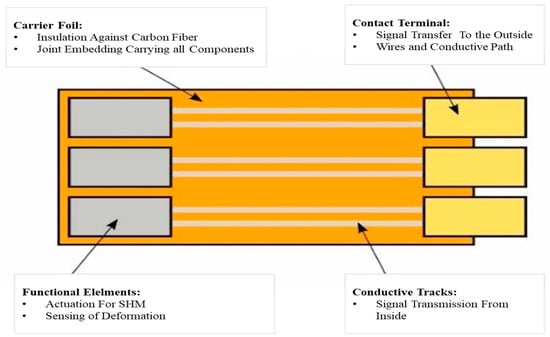
Figure 3.
Basic TEmSAL components. Reproduced from [26] with permission from IOPScience.
A similar concept was extensively demonstrated by the Stanford Multi Actuator Receiver Transduction Layer (SMART Layer®) [27,28]. The SMART Layer® is a commercial impact monitor system utilizing the sensing capabilities of Piezoelectric Wafer Active Sensors (PWAS) arrayed and connected to printed circuit cells [27,28]. It was developed by Acellent Technologies. PWAS is a promising embedded BVID detection technology for composite structures. It has high sensitivity and a quick response time and can be designed in various shapes and sizes. Additional research is required to fully comprehend the performance and limitations of PWAS integrated into composite material structures under different thermal or mechanical loading conditions.
Multiple studies [27,29,30,31,32,33] have examined the influences of mechanical loadings, temperature, humidity, and extreme environments on the SMART layer.
Coles et al. studied the performance of embedded PZT sensors on composite structures based on a time-reversal image processing technique received by a single sound wave signal when the diffusive wave field conditions are met. (Figure 4) [34].
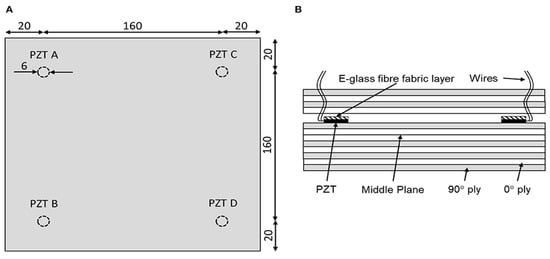
Figure 4.
Locations of embedded PZTs in the CFRP plate (A) and the lay-up of the CFRP plate (B) Dimensions in mm. Not to scale [33,34].
A controlled spatial arrangement approach, named the minimum average (MA) method, was proposed to enhance the accuracy of sound waves received with time reversal in retrieving the location of impact. The Modified Algorithm approach uses differences from the minimum time reversal correlation coefficient value at the impact cell’s four corners instead of the actual values. Similar to the center of gravity (COG) technique, this method introduces more flexibility in localization by allowing deviations from the cell’s geometric center. Its primary aim is to enhance precision for off-center impacts and instances where an incorrect cell is predicted rather than resolving the wrong cell selection. Experiments were conducted to justify the strength and consistency of induced sound waves’ time reversal against traditional spatial arrangements by altering responses in the signal origins (Figure 5). All impacts were induced by dropping a pencil from a consistent height of 85 mm. The proposed minimum average method showed promise for enhancing the accuracy of impact localization.

Figure 5.
Calculated real impact position for the COG method (A) and the new topological MA approach (B) applied to TR with cell-centered impacts and no grid refinement. Creative Commons Attribution License (CC BY).
3.2. FBG Sensors
FBG sensors have cemented their position as a potent tool for damage detection within composite materials. The operational essence of FBG sensors lies in the controlled modulation of the refractive index within a fiber’s core. When illuminated by a broad-spectrum light source, the FBG reflects a distinct Bragg wavelength, which undergoes shifts in response to changes in strain or temperature. These shifts provide insights into the composite’s structural health. Figure 6 illustrates the FBG operation principle.
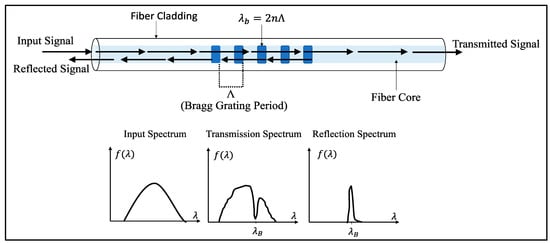
Figure 6.
Illustrations of the FBG operation principle.
Embedding FBG sensors within composite materials has been refined over the years to optimize sensor performance and ensure minimal disturbance to the composite’s intrinsic properties. Typically, FBG sensors are integrated within the interlaminar regions of the composite during its lay-up process, ensuring that they remain in intimate contact with the composite matrix. This strategic placement allows the sensors to capture the mechanical perturbations and strain variations with enhanced sensitivity, especially those resulting from impacts.
When juxtaposed with PZT sensors, FBG sensors reveal several merits. Firstly, FBGs exhibit inherently constructive interference with electromagnetic waves, enhancing their reliability in electrically noisy environments. This contrasts with PZTs, which can be susceptible to such interferences. Secondly, the lightweight and small form factor of FBG sensors makes them less intrusive when embedded within composites. Moreover, FBGs allow for multiplexing, wherein multiple arrays of sensors can be integrated along a single optical fiber core, providing a comprehensive spatial distribution of measurements. This multiplexing capability often surpasses the spatial resolution achievable with conventional PZT arrays.
Many studies have explored the monitoring of composite materials using fiber optic sensors, with a particular focus on diminutive structures such as flat panels and gas cylinders, as evidenced in prior studies [35,36,37]. Qu et al. also explored diverse methodologies for monitoring the structural response of a carbon-fiber composite cylinder under internal pressure loading conditions, utilizing integrated optical fiber sensors [38]. Huan et al. studied the subsurface damage in BK7 glass when scratched with a single abrasive, looking at how strain rate and temperature affect the material [39]. They wanted to see how these factors influence material properties, the size of the plastic deformation zone, and the start and growth of cracks such as lateral and median cracks. For their experiment, they used a special cutting tool they developed, featuring a cemented carbide cutter with a fixed fillet radius of 200 μm. This setup created a negative rake angle of 53° and, due to the large radius of gyration (250 mm), the scratching path was almost a straight line. Their findings showed that the strain rate in the small contact area affects material properties such as hardness, yield strength, and fracture toughness, as well as the plastic deformation zone created by the scratching process. They also found that higher temperatures from faster scratching speeds reduced the radius of the plastic deformation zone, shortened crack lengths, decreased brittle fractures, and minimized subsurface damage [39].
In the domain of impact detection, FBG sensors have exhibited pronounced efficacy. Impacts, ranging from low-energy, barely perceptible events to more intense strikes, generate stress waves within the composite structure. These waves, characterized by distinct amplitude, frequency, and speed, provide a rich tapestry of information about the nature of the impact. As these waves propagate and interact with the embedded FBG sensors, they induce strain variations, resulting in Bragg wavelength shifts. Through advanced signal processing and data analytics, these wavelength shifts can be decoded to furnish details not just about the presence of an impact but also its magnitude, location, and potential implications for the composite’s structural integrity. This nuanced, real-time feedback is instrumental in early damage detection and informed maintenance decisions.
FBG sensors can sense BVID; however, they are frequently embedded in the mid-plane, where residual strains triggered by impact are lower, leading to an underestimation of the extent of the damage [40,41]. Rocha et al. compared the residual strains caused by low-velocity impact events as measured by an FBG sensor integrated at the mid-plane with others situated over the entire thickness of the CFRP composites [42]. Multiple low-velocity impacts ranging from 13 J to 40 J were applied to the instrumented laminates while FBG sensor responses were collected. The FBG sensor responses enabled the measurement of residual strain after damage and the detection of the maximum strain at the time of impact, information essential for identifying the presence and nature of BVID in real-world applications. The optimal location for optical fiber embedding for BVID detection was chosen based on the findings. It compared how small (70 µm) and large (150 µm) optical fiber diameters affected CFRP’s impact resistance. This study revealed that FBG sensors embedded closer to the bottom layers of the laminate detected residual strains up to 38 μm/μm in the small-diameter optical fiber and 35 με in the large-diameter optical fiber after a 20 J impact, while those in the mid-plan showed significantly lower values. Additionally, strain peaks reaching 8000 μm/μm were identified upon impact, emphasizing the sensor’s capability in real-life damage identification [42].
For micro-damage detection in thin structures, it is ideal that the sensors be integrated closer to the bottom layers, where the damage extent can be evaluated more accurately, closer to the model-damaged layers. The study also concluded that there was no apparent advantage to using small optical fibers over larger ones since the impacts produced equivalent levels of absorbed energy in the impacted laminates [40].
Hafizi et al. reported using an optical fiber with two channel-two NIR-FBG sensors to detect the location of impact on a GFRP/epoxy laminate that was 4 mm thick (Figure 7) [43].

Figure 7.
Experimental setup for impact location detection. Reproduced from [43] with permission from Elsevier.
The linear impact location was calculated using the time of arrival (TOA) method, assuming a 1D structure with two sensors [37,43], according to the following equation:
where I2 denotes linear impact location, Cg stands for the group velocity of the wave, and L is the linear length between sensors.
The velocity of the group of waves traveling on the sensor specimen is represented by Cg in Equation (1). The strain mode will be the determining wave propagation result for an impact on a thin composite specimen, as determined by the specimen’s dispersion curves. Figure 8 depicts the impact event signals collected by the sensors [43].
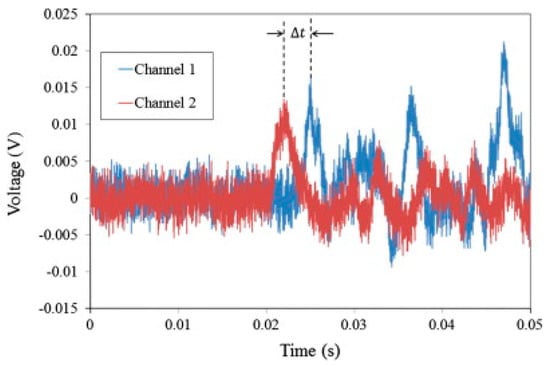
Figure 8.
Sample signals from the two—channel NIR-FBG sensors due to an impact at point A. Reproduced from [43] with permission from Elsevier.
Utilizing FBG sensors for the detection of micro-cracks and pinpointing their locations in composites has seen progressive advancements. Specifically, Li et al. illustrated the potential of embedded FBG sensors in unidirectional CFRP to sense and locate impacts [44]. Their novel approach combined support vector regression with a back propagation neural network in an ensemble learning model, enhancing precision in impact location recognition. Figure 9 illustrates the impact detection system. When subjected to multiple impacts, the data from FBG sensors effectively trained this model, showing marked superiority over conventional neural networks (Figure 8).
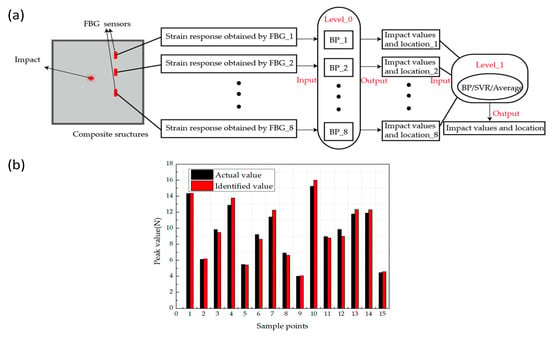
Figure 9.
(a) Schematics of impact sensing based on ensemble learning, and (b) peak values using ensemble learning [44]. Creative Commons Attribution (CC BY).
The model’s accuracy was notably improved by incorporating the time of arrival (ToA) of strain signals. This highlights its importance even amidst the complexities of unidirectional CFRPs. This research emphasizes the potential of integrating FBG sensors with sophisticated algorithms for real-time, accurate impact detection in composites (Figure 10). However, the true efficacy of this approach in more complex configurations remains an avenue for future exploration. The synergy between FBGs and neural networks exemplifies the cutting-edge evolution of damage detection methodologies, reinforcing the evolution of AI as a pivotal ally in advancing SHM technologies.
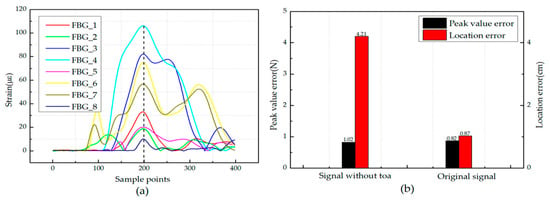
Figure 10.
(a) Strain results of various FBG sensors and (b) comparison of impact identification results without ToA information and basic data [43].
Gilbert et al. studied the robustness of embedded fiber optic sensor mesh configurations for monitoring composite structures [45]. They investigated various configurations of embedded fiber Bragg grating sensors aimed at enhancing their resilience in monitoring composite structures. The configurations, including single-ended line, bidirectional line, loop, and 2 × 2 mesh, are subjected to analysis using a probabilistic model to assess the robustness of the sensor system. Figure 11 shows the adopted 2 × 2 mesh, single-ended line, bilateral line, and loop configurations for FBG sensors, where F and S represent faults in the fiber and sensors, respectively. A numerical assessment of these configurations indicated that the 2 × 2 mesh configuration exhibited superior robustness compared to others across all probabilities of inlet port failure. The likelihood of a sensor being isolated within the 2 × 2 mesh configuration is approximately three times lower than within the bidirectional line configuration [45].
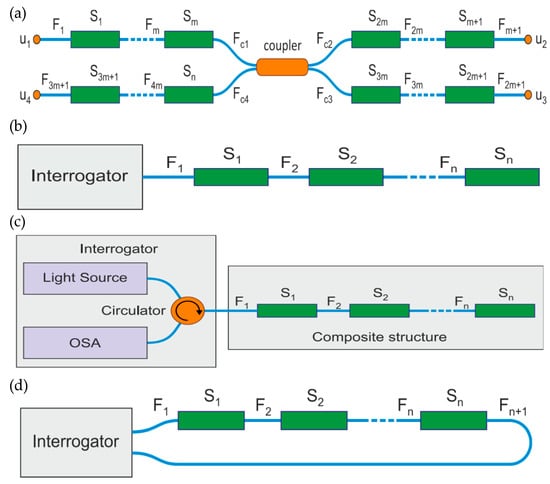
Figure 11.
(a) 2 × 2 Mesh configuration of FBG sensor, (b) Single-ended line configurations of FBG sensor, (c) Line Configurations of FBG sensor, and (d) Loop Configuration of FBG sensor [45].
3.3. Other Sensing Technologies
In situ triboluminescent optical fiber (ITOF) sensors have emerged as a promising technology for SHM. These sensors ingeniously merge the triboluminescent (TL), or mechanoluminescent (ML), phenomenon, in which light emission is activated by mechanical stress, with the light-guiding characteristics of optical fibers. Drawing parallels with the neural networks of the human nervous system, the ITOF sensor integrates sensing and transmission systems, enabling real-time and distributed damage monitoring in composite materials. The TL material embedded within the optical fiber releases light upon experiencing mechanical stress. This emitted light is then channeled through the optical fiber to a detector, facilitating remote structural monitoring. The design of the ITOF sensor aims to detect and convey damage-induced TL emissions without the need to embed TL crystals in the matrix directly, as shown in Figure 12. It has been incorporated into composite systems, leading to multifunctional composites that blend load-bearing with in-process damage-monitoring capabilities.
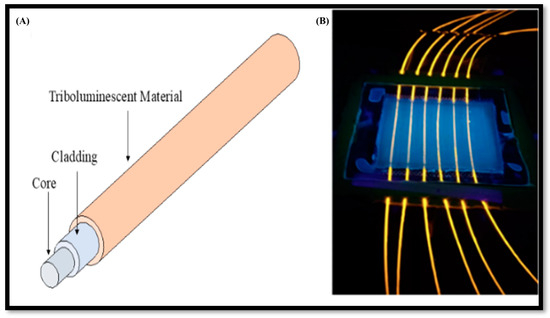
Figure 12.
(A) Schematic representation of ITOF sensor. (B) Glass fiber composite with an embedded ITOF sensor under a 365 nm UV lamp. Reproduced from [46] with permission from Elsevier.
However, employing ITOF sensors for BVID detection is challenging. Issues such as interference from external light sources, including ambient light or other triboluminescent sources, pose significant hurdles. Overcoming these necessitates designing the sensor and its associated measurement setup to resist interference as much as possible. Previous investigations into using ITOF sensors in composite structures to detect BVID have been conducted [47,48]. In these studies, ITOF sensors of varying dimensions were embedded in composite laminates, demonstrating their potential to detect BVID with remarkable sensitivity. For comprehensive monitoring of a composite structure, it is advised that sensors be spaced at intervals of 15 mm, 8 mm, or 5 mm for ITOF sensors measuring 1500 mm, 570 mm, and 275 mm, respectively. These studies highlighted the capability of ITOF sensors to reliably detect BVID under diverse loading and environmental conditions. This was further exemplified by subjecting a five-layer woven CFRP/Vinyl ester, with midplane-embedded ITOF sensors, to impacts at five distinct energy levels (0.066, 0.132, 0.214, 0.296, and 0.379 J) over multiple cycles using a specialized impact rig. The accumulated evidence indicates the potential proficiency of ITOF sensors in identifying BVID within composite structures [49].
3.3.1. ML–Perovskite Sensors
ML–Perovskite sensors integrate the light-emitting and light-absorbing principles from ML and perovskite materials, respectively. The ML layer used in these sensors emits light in response to mechanical stimuli. This makes them suitable for real-time, in situ SHM applications. The perovskite material absorbs the emitted light and converts it into an electrical signal, allowing easy integration with existing SHM systems. Integrating ML devices with perovskite materials can be used to develop a flexible, sensitive, and self-powered pressure sensor. The seamless integration of the ML material with the perovskite device prevents light loss from the ML source (ZnS:Cu), making the sensor more efficient than conventional ML-based sensors [49,50,51,52,53]. Recent investigations showed that the ML–perovskite sensor could detect energy impacts as low as 0.4 J when embedded in the midplane of a six-layer CFRP/vinyl ester [54]. Our previous study demonstrated the potential of these sensors by embedding them within a composite plate and analyzing the changes in their electrical current to pinpoint impact locations [55]. By placing the sensors at the composite structure’s corners and applying the centroid algorithm method, it was possible to detect and accurately estimate low-energy impact locations with reasonable accuracy, as seen in Figure 13. However, challenges still need to be addressed to fully realize the capability of ML–perovskite sensors for BVID detection in composite structures. One of the main challenges is the stability of the sensors. The perovskite compounds used in the sensors are sensitive to moisture, heat, and other environmental factors, which can affect the lifetime and performance of the sensors. Therefore, further research is needed to develop methods to protect the sensors from these factors and extend their lifetime.
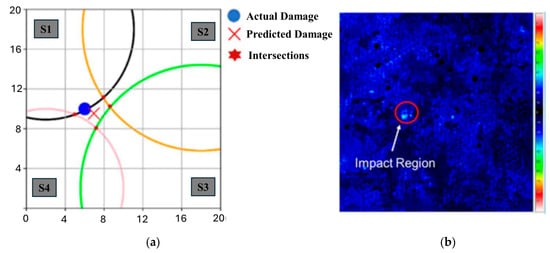
Figure 13.
(a) The schematic of the centroid localization algorithm and (b) C-scan of the composite laminate after impact [55].
3.3.2. Mechanochromic Sensors
Mechanochromic sensors are gaining prominence in SHM due to their ability to visually detect damage in composite materials, presenting potential utility for BVID detection. These sensors change colors based on material health levels, providing a wireless, lightweight, real-time alternative to conventional methods. Two main types exist: chemical-based, which leverages dye-filled microcapsules or modified polymers infused with mechano-phores, and physical-based, which either utilizes structural colors from nano-patterns or relies on hybridized composites where reflected light from interfacial damage serves as a visual indicator. Despite their innovative nature, challenges such as manufacturing scalability, potential interference from environmental stimuli, and application versatility need addressing. As research progresses, these sensors hold a promise to redefine SHM, ushering in safer and more efficient engineering solutions. More information about these sensors can be seen in an extensive review paper on this subject [56]. Several materials have been developed and used as sensors for SHM in the literature.
Carbon Nanotubes (CNTs) are rolled-up sheets in cylindrical nanostructures composed entirely of carbon atoms and with diameters ranging from 0.5–2.0 nanometers, about 100,000 times thinner than the width of a human hair. Due to their exceptional tensile strength, thermal conductivity, and electrical properties, CNTs have been explored for various applications, including as sensors in composite materials [39,56,57,58]. When embedded in a composite material, CNTs can detect strain and temperature changes and enable remote monitoring of the structure’s health in real-time. Aly and Bradford studied CNTs as damage sensors for SHM in composites [59]. Their work investigated the performance of CNT sheets embedded in GFRP under different impact strikes. The results showed a correlation between the sensor’s electrical resistance change and the impact damage modes in the structure [57].
Resistance measurements from a CNT-sensing network can provide a rapid preliminary evaluation of the state of the damage. However, effective electrical impedance tomography was shown to pinpoint the location of damage [58] more precisely. This is an imaging technique that redistributes the spatial conductivity from a set of constant measurements and can be used to determine the extent of damage in composite structures [59].
Hao et al. investigated the improvement of a CNT-film-based electrical impedance tomography (EIT) system for detecting the damage in CFRP composites using the conductive network of a CNT film itself as the sensing material [58]. The film was made up of 16 electrodes that measured 100 × 100 mm2. The carbon-fiber prepreg was hybridized with the CNT film, and the pressure status and introduction of the impact damage during the very slow-motion indentation were successfully monitored in the final composite matrix. By laminating this sensing layer on the surface or in the middle of a composite matrix, the detectability of the CNT film was compared, as seen in Figure 14.
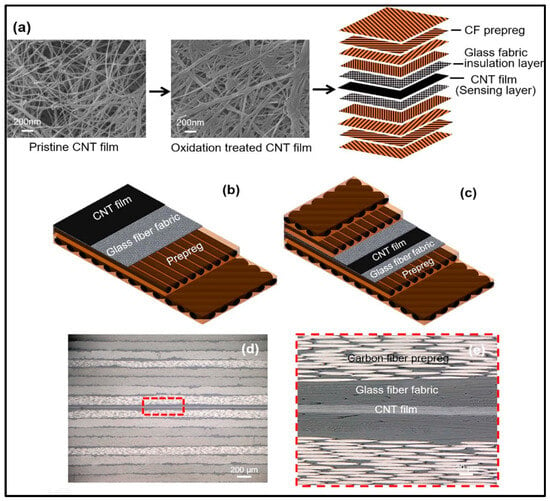
Figure 14.
(a) CNT film treatment and the ply scheme of a hybrid composite; schematic diagrams of (b) s-CNT/CF and (c) m-CNT/CF hybrid composites; and (d,e) cross-sectional morphologies of a CNT/CF hybrid composite. Reproduced from [58] with permission from the American Chemical Society.
The results from the surface-attached CNT sensing sheet show that the CNT-film-based EIT system detects stress due to indentation at an elongation of 3 mm. The CNT film has a maximum dimension between 3.55–4.54 mm in the current EIT system design (Figure 15) to detect stress distribution and damage. However, when embedded in the midplane, the CNT film revealed an unmistakable array of indentation stress distribution and damage in the EIT image, even at a 1 mm indentation elongation. Compared to its surface-attached counterpart, the embedded sensing sheet has a higher range for detecting stress distribution and damage due to indentation [58].
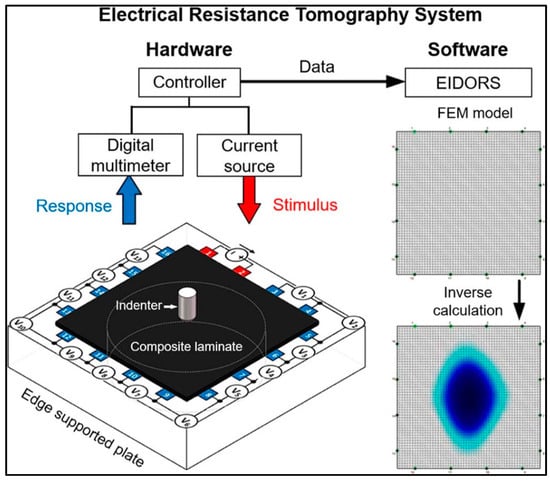
Figure 15.
Quasi-static indentation methodology and conceptual diagram of the EIT system. Reproduced from [58] with permission from the American Chemical Society.
3.3.3. MXenes
MXenes are two-dimensional (2D) inorganic compounds that consist of transition metal carbides, borides, nitrides, or carbonitrides. They were first reported in 2012 and have since been recognized for their potential in various applications. Their hydrophilic terminations make them suitable for sensors, and their high metallic conductivity makes them attractive for composite materials. When embedded within a composite material, MXenes can detect the composite’s response to changes in strain and temperature, allowing for remote monitoring and analysis of the structure’s health [60,61,62,63].
MXene has higher conductivity (2.4 × 105 S/m) than CNTs (400 S/m) [62]. Furthermore, MXene’s microstructure characteristics are structured in a layer-by-layer form, allowing it to be developed as an extremely sensitive pressure sensor [61].
Zhang et al. revealed that MXene materials could be integrated into a composite overwrapped pressure vessel (COVP) and effectively monitor the frequency change transmitted to the entire body of the COVP at the time of impact, as well as respond to ultra-low-energy impacts, which can potentially cause BVID [63]. The location of impact in the tests under varying energies and positions can be determined using the response pattern of the MXene sensor array. The intensity of impact energy can also be calculated based on the sensor’s resistance change.
Comprehensive research is required to fully comprehend the capabilities of MXenes as embedded sensors for BVID detection in composites and to develop practical and reliable sensing techniques [61,63].
Semiconductor materials can exhibit significant resistance changes in response to strain, exhibiting excellent piezoresistivity. Due to their excellent thermal conductivity and semi-conductive properties, Silicon Carbide (SiC) fibers have attracted considerable interest in SHM applications [64,65,66,67].
Kwon et al. fabricated and embedded SiC fibers into composites for impact sensing and localization [64,67]. The impact location, based on source data, was performed for various fiber arrangements. The authors compared and investigated the effects of the arrangement and location of SiC fibers on the impact localization performance according to the arrangement of SiC fiber sensors. When the SiC fiber sensors are arranged in the direction of the reinforcing fibers, they can serve as both the load-bearing component and the sensing element. Alternatively, the arrangement configuration and position of the SiC fiber sensors were constrained or limited.
In addition, the accuracy of the precise location of impact was enhanced by employing the optimal sensor configuration in consideration of similar impact signal distribution characteristics. Therefore, the location of impact in the composite structure was successfully performed using an integrated SiC fiber sensor network. In composite materials, the integrated piezoresistive fibers can function as a sensing element while limiting structural disturbance, and as a load-bearing component. The group concluded that SiC fibers are a suitable element for developing multifunctional composites with multi-sensing capabilities [64,67].
Table 1 summarizes embedded sensing technologies used for impact detection with some merits and demerits.

Table 1.
Comparative analysis of impact detection sensors in composite materials.
4. Challenges and Prospects
The paramount challenge lies in the mechanical intrusiveness of sensor embedment. The incorporation process, especially during high-density embedment scenarios, risks compromising the intrinsic mechanical properties of the composite, further compounded by phenomena such as resin pocket surges.
Despite the promising advancements and capabilities of embedded piezoelectric sensors, their integration and application in composite materials present distinct challenges. Foremost among these is the durability and sustainability of the sensors within the composite matrix. Given the diverse and often aggressive operational environments these composites are subjected to, ensuring consistent sensor performance over extended periods is paramount. The embedding process may also introduce mechanical or thermal stresses, potentially compromising the sensor’s integrity and the host composite’s mechanical properties. Data interpretation also poses hurdles. The electrical signals generated by the sensors, particularly in a complex event like an impact, can be intricate, necessitating advanced signal processing techniques and algorithms for accurate interpretation. Moreover, sensor miniaturization is challenging while retaining sensitivity, ensuring they do not intrude upon or alter the composite’s inherent structural attributes. As the field progresses, addressing these challenges remains at the forefront of research, underscoring the need for a comprehensive approach that balances sensor capabilities with the practicalities of real-world applications.
The quest for sensor miniaturization introduces complexities. Ensuring the fidelity, durability, and precision of minuscule sensors becomes imperative. Moreover, the data from enhanced sensors necessitate robust wireless communication frameworks for data relay, coupled with advanced AI-driven interpretation mechanisms for real-time analysis.
Economic viability, rigorous standardization protocols across diverse sensor modalities, and long-term resilience in adverse operational environments also emerge as salient challenges.
While FBG sensors have displayed remarkable promise in SHM within composites, their implementation is not without challenges. A primary concern is the potential vulnerability of these sensors to physical damage during the embedding process, which could compromise their sensitivity or lead to outright failure. The precise alignment of the grating within the composite matrix is crucial, and any misalignment could result in suboptimal performance. Furthermore, the long-term stability of FBGs in the face of mechanical fatigue, environmental aging, and exposure to harsh conditions remains a topic of investigation. Signal attenuation via intruding light emission, particularly in densely multiplexed FBG systems, can also pose challenges in achieving consistent, accurate damage detection. Additionally, the intricate nature of signals generated from impacts necessitates advanced algorithms for data interpretation, and refining these algorithms for real-world scenarios is an ongoing endeavor. Drastically limiting these challenges is imperative to fully harness the capabilities of FBG-based sensors in composite health monitoring.
The same principles apply to PZTs and other sensors, whose physical dimensions and rigidity might not align with the flexible nature of some composites, leading to stress concentrations and potential failure points. Another challenge is the sensor’s sensitivity and signal-to-noise ratio; false positives or missed detections can drastically reduce the system’s reliability. Environmental factors, such as temperature fluctuations and moisture ingress, can affect sensor performance or even lead to their degradation over time. The longevity and durability of embedded sensors are also a concern, especially when the host structure is meant to last for decades. Furthermore, data interpretation and analysis can become complex with the increasing number of sensors and the variety of damages to be detected. Newer sensors offer higher resolution and accuracy but might demand more sophisticated and sometimes power-consuming electronics for data interpretation. Balancing these challenges while ensuring robust, reliable, and real-time SHM remains a focal point for ongoing research in composite monitoring.
4.1. Durability of Embedded Sensors under Mechanical Stress
The application of acoustic emission (AE) sensors within composite materials has garnered significant attention across various sectors, including the automotive, aerospace, and energy industries. A notable advantage is the discernment of failure mechanisms through distinct waveform analysis. For instance, within glass fiber composites, crack-induced failure mechanisms can be elucidated by analyzing the frequency spectra of emitted waves [98]. Ghadarah et al. examined the performance of embedded acoustic emission sensors in a glass fiber composite under mechanical loading [95]. They employed silver ink-coated plated polyvinylidene difluoride PVDF, gold (PVDF), and lead zirconate titanate (PZT) piezoelectric sensors for acoustic emission (AE) detection. The silver ink-coated PVDF sheet exhibited a film thickness of 28 µm and a total thickness of 40 µm (including a protective layer) and was fabricated through vacuum resin infusion and tested using three-point bending and the double cantilever beam (DCB) mode I mechanical testing method [93]. After assessing sensitivity relative to identical impacts, the fully embedded sensor generally exhibited comparable or diminished sensitivity in contrast to the surface-embedded sensor influenced by the frequency of acoustic emissions correlated with failure events, rather than the location of crack initiation. Further examination, involving the decomposition of the frequency energy distribution within the acoustic emission signal into distinct bands (0–65 kHz, 60–129 kHz, and 121–500 kHz), revealed discernible disparities in frequency energy content between surface-embedded and fully embedded sensors.
While extant research is sparse concerning the long-term robustness of AE sensors integrated within fiber-reinforced composites, additional inquiry is imperative to define the rationale behind the prevalence of surface-embedded sensors in high low-frequency-failure scenarios. Should the frequency-dependent phenomenon persist across varied reinforcement materials, composite thicknesses, and manufacturing techniques, the complete embedding of acoustic emission sensors within polymer-reinforced composites is ill-advised due to substantial associated drawbacks.
4.2. Piezoresistive Sensors under Cyclic Loading
Rao et al. devised an embeddable smart composite-based sensor (eSCS) and conducted real-time monitoring of both the structure and the sensors during extreme loading conditions [99]. The sensors were synthesized by integrating functionalized (-COOH) multi-walled carbon nanotubes (MWCNTs), with their peak conductivity and piezo-resistivity determined by an optimal dosage of CNTs. Following the characterization of these sensors, they were integrated into an exterior beam-column sub-assemblage and subjected to reverse cyclic loading (earthquake-like loading) to assess their damage-sensing capability. Results from their experimental investigation indicated that under cyclic compressive loading, sensors containing 0.10 wt.% CNT exhibited an irreversible and unstable response. Conversely, higher concentrations of CNT within the cementitious composite-based matrix enhanced the reversibility and stability of the sensors. Sensors with 0.50 wt.% CNT demonstrated an outstanding reversible and stable response consistent with the applied cyclic compressive load. Additionally, the strain sensitivities of the sensors increased up to a CNT concentration of 0.50 wt.%, with a further increase leading to decreased sensor sensitivity. An intriguing observation was the reduction in strain sensitivity of the sensors with increasing compressive stress magnitude. Sensors with a 0.50 wt.% CNT concentration exhibited the highest strain sensitivities. For compressive stresses ranging from 2–4, 2–6, and 2–8 MPa, the strain sensitivity (gauge factor) was approximately 730.85, 457.97, and 396.36, respectively, surpassing previously reported values for sensors of this class [99].
Further advancement of embeddable smart composite sensors necessitates increased research efforts focused on factors such as embedding depth, bond behavior, loading conditions, structural configurations, environmental variations, and related parameters.
5. Future Directions
Embedded sensors have emerged as a critical focal point, catalyzing significant advancements in real-time SHM. The synergy between embedded sensors and computational prowess is poised to redefine the paradigms of impact detection and response. With the proliferation of machine learning and artificial intelligence (AI) methodologies, there is a tangible shift towards predictive analytics. Operating with sophisticated algorithms, embedded sensors are anticipated to transition from mere detection entities to prognostic systems, extrapolating potential impact-induced damages from extant data sets and patterns.
AI techniques, including image-, vibration-, and acoustic-based methods, are increasingly employed for detecting BVID in composites [84,85,86,87,88,89,90,91]. Research has effectively utilized Deep Learning (DL) and Machine Learning models to characterize impact damage, with applications ranging from analyzing wave propagation to infrared thermography. However, challenges persist in data collection, requiring specialized equipment in order to ensure real-world applicability, such as considering composite reflectivity. Recent advancements have focused on predicting BVID from simple surface images and exploring the potential for fully autonomous SHM systems.
Tabatabaeian et al. explored low-velocity impact tests on composite panels with and without integrated sensors, establishing a unique BVID image dataset from the results and other visual inspection techniques [85]. Four deep learning models were developed, using simple surface images to discern BVID. Findings revealed that different Convolutional Neural Networks (CNNs) can be trained for BVID detection, with back-face images offering higher accuracy due to more evident damage patterns. All models effectively identified BVID, with ResNet outshining others, achieving an accuracy of 96.2% and 98.36% on the back-face of source and sensor-integrated panels, respectively. Integrating hybrid glass/carbon sensors significantly enhanced damage detection accuracy, especially on the front face, by starkly contrasting damaged and undamaged areas. This sensor integration improved accuracy and reduced training time, optimizing the computational capabilities of AI-driven damage detection systems [86].
6. Conclusions
This review has presented the fundamentals, fabrication procedures, working mechanisms, and the application of different sensors for SHM. The review of the studies on SHM shows that embedded sensors are a promising technology for impact detection and monitoring in composite structures. Several types of sensors, such as FBGs, PZTs, CNTs, ITOF, and ML–Perovskite, have been proposed and studied for SHM. These sensors have different sensitivities and sensing mechanisms, making them suitable for different applications and environments. Embedded sensors can provide real-time monitoring of the structural health of composite materials, which is essential for the safe and efficient operation of critical infrastructures.
However, several challenges must be overcome to fully realize the potential of embedded sensors for impact detection in composites. One of the main challenges is the integration of sensors into the composite material, which requires developing new techniques and materials. Another challenge is the durability and reliability of sensors in harsh environments, which can thus affect their performance over time. Furthermore, interpreting sensor signals and developing data analysis algorithms are fundamental challenges that must be addressed.
Sensitivity is a crucial parameter for an efficient embedded pressure sensor. Improvement of an embedded sensor is quite challenging as well. It is found that the incorporation of microstructures into the active mass of a sensor decreases conductive paths, and the sensitivity of a sensor device is increased. However, it is still challenging to simultaneously achieve high sensitivity in low- and high-pressure ranges for flexible sensor devices. Using embedded sensors for impact detection and potential BVID monitoring in composites can revolutionize monitoring and maintaining critical infrastructures. However, further research and development is needed to overcome the current challenges and fully realize this potential.
Author Contributions
Conceptualization, L.B.C. and O.I.O.; resources, O.I.O.; writing—original draft preparation, L.B.C.; writing—review and editing, J.H., M.M.R. and O.I.O.; visualization, L.B.C. and J.H.; supervision/coordination, M.M.R. and O.I.O.; project administration, O.I.O.; funding acquisition, O.I.O. All authors have read and agreed to the published version of the manuscript.
Funding
This work was supported by research funds from the NSF REU RETREAT program with Award Number: 1950500.
Data Availability Statement
No new data was created or analyzed in this study. Data sharing is not applicable to this article.
Conflicts of Interest
The authors declare no conflict of interest.
References
- Shirvanimoghaddam, K.; Hamim, S.U.; Karbalaei Akbari, M.; Fakhrhoseini, S.M.; Khayyam, H.; Pakseresht, A.H.; Ghasali, E.; Zabet, M.; Munir, K.S.; Jia, S.; et al. Carbon Fiber Reinforced Metal Matrix Composites: Fabrication Processes and Properties. Compos. Part Appl. Sci. Manuf. 2017, 92, 70–96. [Google Scholar] [CrossRef]
- Sathishkumar, T.; Satheeshkumar, S.; Naveen, J. Glass Fiber-Reinforced Polymer Composites—A Review. J. Reinf. Plast. Compos. 2014, 33, 1258–1275. [Google Scholar] [CrossRef]
- Hsissou, R.; Seghiri, R.; Benzekri, Z.; Hilali, M.; Rafik, M.; Elharfi, A. Polymer Composite Materials: A Comprehensive Review. Compos. Struct. 2021, 262, 113640. [Google Scholar] [CrossRef]
- Hamdan, A.; Sultan, M.T.H.; Mustapha, F. Structural Health Monitoring of Biocomposites, Fibre-Reinforced Composites, and Hybrid Composite. In Structural Health Monitoring of Biocomposites, Fibre-Reinforced Composites and Hybrid Composites; Elsevier: Amsterdam, The Netherlands, 2019; pp. 227–242. ISBN 978-0-08-102291-7. [Google Scholar]
- Rocha, H.; Semprimoschnig, C.; Nunes, J.P. Sensors for Process and Structural Health Monitoring of Aerospace Composites: A Review. Eng. Struct. 2021, 237, 112231. [Google Scholar] [CrossRef]
- Giurgiutiu, V. Structural Health Monitoring of Aerospace Composites; Elsevier Science and Technology Books, Inc.: Amsterdam, The Netherlands, 2016; ISBN 978-0-12-410441-9. [Google Scholar]
- Ferreira, P.M.; Machado, M.A.; Carvalho, M.S.; Vidal, C. Embedded Sensors for Structural Health Monitoring: Methodologies and Applications Review. Sensors 2022, 22, 8320. [Google Scholar] [CrossRef]
- Janeliukstis, R.; Mironovs, D. Smart Composite Structures with Embedded Sensors for Load and Damage Monitoring—A Review. Mech. Compos. Mater. 2021, 57, 131–152. [Google Scholar] [CrossRef]
- Tuloup, C.; Harizi, W.; Aboura, Z.; Meyer, Y.; Khellil, K.; Lachat, R. On the Use of In-Situ Piezoelectric Sensors for the Manufacturing and Structural Health Monitoring of Polymer-Matrix Composites: A Literature Review. Compos. Struct. 2019, 215, 127–149. [Google Scholar] [CrossRef]
- Tuloup, C.; Harizi, W.; Aboura, Z.; Meyer, Y. Integration of Piezoelectric Transducers (PZT and PVDF) within Polymer-Matrix Composites for Structural Health Monitoring Applications: New Success and Challenges. Int. J. Smart Nano Mater. 2020, 11, 343–369. [Google Scholar] [CrossRef]
- Sohn, M.S.; Hu, X.Z.; Kim, J.K.; Walker, L. Impact Damage Characterisation of Carbon Fibre/Epoxy Composites with Multi-Layer Reinforcement. Compos. Part B Eng. 2000, 31, 681–691. [Google Scholar] [CrossRef]
- He, C.; Li, Y.; Zhang, Z.; Sun, Z. Impact Damage Modes and Residual Flexural Properties of Composites Beam. J. Reinf. Plast. Compos. 2008, 27, 1163–1175. [Google Scholar] [CrossRef]
- Agrawal, S.; Singh, K.K.; Sarkar, P. Impact Damage on Fibre-Reinforced Polymer Matrix Composite—A Review. J. Compos. Mater. 2014, 48, 317–332. [Google Scholar] [CrossRef]
- English: Bird Strike–Aircraft AMX–Brazilian Air Force; 2007. (Bird Strike—Amazing Damage|Aircraft, Bird Strike, Fighter Jets). Available online: https://www.pinterest.com/#top (accessed on 20 April 2024).
- Petit, S.; Bouvet, C.; Bergerot, A.; Barrau, J.-J. Impact and Compression after Impact Experimental Study of a Composite Laminate with a Cork Thermal Shield. Compos. Sci. Technol. 2007, 67, 3286–3299. [Google Scholar] [CrossRef]
- Sadighi, M.; Alderliesten, R. Impact Fatigue, Multiple and Repeated Low-Velocity Impacts on FRP Composites: A Review. Compos. Struct. 2022, 297, 115962. [Google Scholar] [CrossRef]
- Tai, N.H.; Yip, M.C.; Lin, J.L. Effects of Low-Energy Impact on the Fatigue Behavior of Carbon/Epoxy Composites. Compos. Sci. Technol. 1998, 58, 1–8. [Google Scholar] [CrossRef]
- Talreja, R. Damage and Fatigue in Composites—A Personal Account. Compos. Sci. Technol. 2008, 68, 2585–2591. [Google Scholar] [CrossRef]
- Saeedifar, M.; Najafabadi, M.A.; Zarouchas, D.; Toudeshky, H.H.; Jalalvand, M. Barely Visible Impact Damage Assessment in Laminated Composites Using Acoustic Emission. Compos. Part B Eng. 2018, 152, 180–192. [Google Scholar] [CrossRef]
- Dolbeer, R.A.; Begier, M.J.; Miller, P.R.; Weller, J.R.; Anderson, A.L. Wildlife Strikes to Civil Aircraft in the United States 1990–2022; Federal Aviation Administration: Washington, DC, USA, 2023. [Google Scholar]
- Chen, X.; Cheng, S.; Wen, K.; Wang, C.; Zhang, J.; Zhang, H.; Ma, H.; Wu, L.; Li, T.; Li, B.; et al. In-situ damage self-monitoring of fiber-reinforced composite by integrating self-powered ZnO nanowires decorated carbon fabric. Compos. B Eng. 2023, 248, 110368. [Google Scholar] [CrossRef]
- Gino, M.E.; Selleri, G.; Cocchi, D.; Brugo, T.M.; Testoni, N.; De Marchi, L.; Zucchelli, A.; Fabiani, D.; Focarete, M.L. On the Design of a Piezoelectric Self-Sensing Smart Composite Laminate. Mater. Des. 2022, 219, 110783. [Google Scholar] [CrossRef]
- Dziendzikowski, M.; Kurnyta, A.; Dragan, K.; Klysz, S.; Leski, A. In Situ Barely Visible Impact Damage Detection and Localization for Composite Structures Using Surface Mounted and Embedded PZT Transducers: A Comparative Study. Mech. Syst. Signal Process. 2016, 78, 91–106. [Google Scholar] [CrossRef]
- Dziendzikowski, M.; Dragan, K.; Katunin, A. Localizing Impact Damage of Composite Structures with Modified RAPID Algorithm and Non-Circular PZT Arrays. Arch. Civ. Mech. Eng. 2017, 17, 178–187. [Google Scholar] [CrossRef]
- Feng, T.; Bekas, D.; Aliabadi, M.H.F. Active Health Monitoring of Thick Composite Structures by Embedded and Surface-Mounted Piezo Diagnostic Layer. Sensors 2020, 20, 3410. [Google Scholar] [CrossRef]
- Hornig, A.; Frohberg, R.; Bätzel, T.; Gude, M.; Modler, N. Embedded Sensing and Actuating in CFRP Composite Structures—Concept and Technology Demonstration for Tailored Embeddable Sensor-Actuator Layers (TEmSAL). Smart Mater. Struct. 2022, 31, 095007. [Google Scholar] [CrossRef]
- Qing, X.P.; Beard, S.J.; Ikegami, R.; Chang, F.-K.; Boller, C. Aerospace Applications of SMART Layer Technology. In Encyclopedia of Structural Health Monitoring; Boller, C., Chang, F.-K., Fujino, Y., Eds.; John Wiley & Sons, Ltd.: Chichester, UK, 2008; p. shm152. ISBN 978-0-470-05822-0. [Google Scholar]
- Lin, M.; Kumar, A.; Beard, S.J.; Xinlin, Q. Built-in Structural Diagnostic with the SMART LayerTM and SMART SuitcaseTM. Smart Mater. Bull. 2001, 2001, 7–11. [Google Scholar] [CrossRef]
- Giurgiutiu, V.; Zagrai, A.N. Embedded Self-Sensing Piezoelectric Active Sensors for On-Line Structural Identification. J. Vib. Acoust. 2002, 124, 116–125. [Google Scholar] [CrossRef]
- Ikegami, R.; Boller, C. History of SHM for Commercial Transport Aircraft. In Encyclopedia of Structural Health Monitoring; Boller, C., Chang, F.-K., Fujino, Y., Eds.; John Wiley & Sons, Ltd.: Chichester, UK, 2008; p. shm125. ISBN 978-0-470-05822-0. [Google Scholar]
- Kumar, A.; Wu, H.F.; Lin, M.; Beard, S.; Qing, X.; Zhang, C.; Hamilton, M.; Ikegami, R. Potential Applications of SMART Layer Technology for Homeland Security; Doctor, S.R., Bar-Cohen, Y., Aktan, A.E., Wu, H.F., Eds.; SPIE: San Diego, CA, USA, 2004; pp. 61–69. [Google Scholar]
- Qing, X.P.; Ikegami, R.; Beard, S.J.; Zhang, D.; Das, S.; Banerjee, S.; Chang, F.-K. Multifunctional Sensor Network for Structural State Sensing and Structural Health Monitoring; Tomizuka, M., Ed.; SPIE: San Diego, CA, USA, 2010; p. 764711. [Google Scholar]
- Garg, D.P.; Zikry, M.A.; Anderson, G.L.; Stepp, D. Health Monitoring and Reliability of Adaptive Heterogeneous Structures. Struct. Health Monit. 2002, 1, 23–39. [Google Scholar] [CrossRef]
- Coles, A.; De Castro, B.A.; Andreades, C.; Baptista, F.G.; Meo, M.; Ciampa, F. Impact Localization in Composites Using Time Reversal, Embedded PZT Transducers, and Topological Algorithms. Front. Built Environ. 2020, 6, 27. [Google Scholar] [CrossRef]
- Tsai, J.T.; Dustin, J.S.; Mansson, J.A. Cure strain monitoring in composite laminates with distributed optical sensor. Compos. Part A Appl. Sci. Manuf. 2019, 125, 105503. [Google Scholar] [CrossRef]
- Zhan, Y.; Han, M.; Wang, Z.; Xu, L.; Song, Z.; Lu, A.; Guo, X.; Deng, W.; Huang, S. Distributed strain monitoring for different composites structures with high resolution based on optical fiber sensing. Optik 2021, 248, 168113. [Google Scholar] [CrossRef]
- Qi, Y.; Jiang, D.; Ju, S.; Zhang, J. Investigation of strain history in fast and conventional curing epoxy matrix composites by FBGs. Compos. Sci. Technol. 2018, 159, 18–24. [Google Scholar] [CrossRef]
- Qu, X.; Li, J.; Shan, Y.; Yang, Z.; Yang, L.; Xu, H.; Liu, M.; Wu, Z.; Zhao, S. Various static loading condition monitoring of carbon fiber composite cylinder with integrated optical fiber sensors. Opt. Fiber Technol. 2024, 83, 103685. [Google Scholar] [CrossRef]
- Su, H.; Drissi-Habti, M.; Carvelli, V. New Concept of Dual-Sinusoid Distributed Fiber-Optic Sensors Antiphase-Placed for the SHM of Smart Composite Structures for Offshore. Appl. Sci. 2024, 14, 932. [Google Scholar] [CrossRef]
- Hegde, G.; Asokan, S.; Hegde, G. Fiber Bragg Grating Sensors for Aerospace Applications: A Review. ISSS J. Micro Smart Syst. 2022, 11, 257–275. [Google Scholar] [CrossRef]
- Rocha, H.; Lafont, U.; Nunes, J.P. Optimisation of Through-Thickness Embedding Location of Fibre Bragg Grating Sensor in CFRP for Impact Damage Detection. Polymers 2021, 13, 3078. [Google Scholar] [CrossRef]
- Hafizi, Z.M.; Epaarachchi, J.; Lau, K.T. Impact Location Determination on Thin Laminated Composite Plates Using an NIR-FBG Sensor System. Measurement 2015, 61, 51–57. [Google Scholar] [CrossRef]
- Li, J.; Yu, Y.; Qing, X. Embedded FBG Sensor Based Impact Identification of CFRP Using Ensemble Learning. Sensors 2021, 21, 1452. [Google Scholar] [CrossRef]
- Gilbert, M.; Bhavsar, K.; Ivanov, O.V. Robustness of embedded fibre optic sensor mesh configurations for monitoring composite structures. Sens. Actuators A Phys. 2024, 373, 115445. [Google Scholar] [CrossRef]
- Shohag, M.A.; Dessureault, Y.-S.; Joshi, K.; Ndebele, T.; Olawale, D.; Dickens, T.; Okoli, O. Enhanced Fabrication Process for in Situ Triboluminescent Optical Fiber Sensor for Multifunctional Composites. Measurement 2018, 121, 240–248. [Google Scholar] [CrossRef]
- Shohag, M.A.S.; Okoli, O.I. Nonparasitic Behavior of Embedded Triboluminescent Sensor in Multifunctional Composites. Compos. Part Appl. Sci. Manuf. 2019, 116, 114–125. [Google Scholar] [CrossRef]
- Shohag, M.A.; Ndebele, T.; Olawale, D.; Okoli, O. Advances of Bio-Inspired In-Situ Triboluminescent Optical Fiber Sensor for Damage and Load Monitoring in Multifunctional Composite. In Proceedings of the Structural Health Monitoring 2017, Stanford, CA, USA, 12–14 September 2017; DEStech Publications, Inc.: Lancaster, PA, USA, 2017. [Google Scholar]
- Braga Carani, L. Investigation of Single Crystal Perovskite for Mechanoluminescence-Based Sensor Application; Florida State University: Tallahassee, FL, USA, 2019. [Google Scholar]
- Braga Carani, L.; Shohag, M.A.; Obiozo Eze, V.; Adams, G.R.; Okoli, O. Embedded Perovskite-Mechanoluminescent Sensor for Applications in Composite Materials. In European Workshop on Structural Health Monitoring; Rizzo, P., Milazzo, A., Eds.; Lecture Notes in Civil Engineering; Springer International Publishing: Cham, Switzerland, 2021; Volume 128, pp. 603–611. ISBN 978-3-030-64907-4. [Google Scholar]
- Carani, L.B.; Eze, V.O.; Iwuagwu, C.; Okoli, O.I. Performance Analysis of Embedded Mechanoluminescence-Perovskite Self-Powered Pressure Sensor for Structural Health Monitoring. J. Compos. Sci. 2020, 4, 190. [Google Scholar] [CrossRef]
- Shohag, M.A.; Adams, G.R.; Eze, V.O.; Ichite, T.; Carani, L.B.; Okoli, O. Mechanoluminescent-Perovskite Pressure Sensor for Structural Health Monitoring. In Proceedings of the Structural Health Monitoring 2019, Stanford, CA, USA, 10–12 September 2019; DEStech Publications, Inc.: Lancaster, PA, USA, 2019. [Google Scholar]
- Shohag, M.A.S.; Eze, V.O.; Braga Carani, L.; Okoli, O.I. Fully Integrated Mechanoluminescent Devices with Nanometer-Thick Perovskite Film as Self-Powered Flexible Sensor for Dynamic Pressure Sensing. ACS Appl. Nano Mater. 2020, 3, 6749–6756. [Google Scholar] [CrossRef]
- Braga Carani, L.; Eze, V.O.; Okoli, O. Effect of Interface Modification on Mechanoluminescence-Inorganic Perovskite Impact Sensors. Sensors 2022, 23, 236. [Google Scholar] [CrossRef]
- Carani, L.B.; Martin, T.D.; Eze, V.O.; Okoli, O.I. Impact Sensing and Localization in Composites Structures with Embedded Mechanoluminescence-Perovskite Sensors. Sens. Actuators Phys. 2022, 346, 113843. [Google Scholar] [CrossRef]
- Tabatabaeian, A.; Liu, S.; Harrison, P.; Schlangen, E.; Fotouhi, M. A Review on Self-Reporting Mechanochromic Composites: An Emerging Technology for Structural Health Monitoring. Compos. Part Appl. Sci. Manuf. 2022, 163, 107236. [Google Scholar] [CrossRef]
- Wan, Y.; Yang, H.; Yuan, Y.; Shen, X.; Yang, B.; Guo, Y.; Xie, Y. Low-Velocity Impact Damage Localization of GF/Epoxy Laminates by the Embedded MWCNT@GF Sensor Network. J. Mater. Res. Technol. 2020, 9, 9253–9261. [Google Scholar] [CrossRef]
- Hao, F.; Wang, S.; Xing, F.; Li, M.; Li, T.; Gu, Y.; Zhang, W.; Zhang, J. Carbon-Nanotube-Film-Based Electrical Impedance Tomography for Structural Damage Detection of Carbon-Fiber-Reinforced Composites. ACS Appl. Nano Mater. 2021, 4, 5590–5597. [Google Scholar] [CrossRef]
- Aly, K.; Bradford, P.D. Real-Time Impact Damage Sensing and Localization in Composites through Embedded Aligned Carbon Nanotube Sheets. Compos. Part B Eng. 2019, 162, 522–531. [Google Scholar] [CrossRef]
- Kuang, K.S.C.; Kenny, R.; Whelan, M.P.; Cantwell, W.J.; Chalker, P.R. Embedded Fibre Bragg Grating Sensors in Advanced Composite Materials. Compos. Sci. Technol. 2001, 61, 1379–1387. [Google Scholar] [CrossRef]
- Lin, L.; Wang, X.; Yang, B.; Zhang, L.; Zhao, Z.; Qu, X.; Lu, Y.; Jiang, X.; Lu, S. Condition monitoring of Composite Overwrap Pressure Vessels Based on Buckypaper Sensor and MXene Sensor. Compos. Commun. 2021, 25, 100699. [Google Scholar] [CrossRef]
- Grabowski, K.; Srivatsa, S.; Vashisth, A.; Mishnaevsky, L.; Uhl, T. Recent Advances in MXene-Based Sensors for Structural Health Monitoring Applications: A Review. Measurement 2022, 189, 110575. [Google Scholar] [CrossRef]
- Wang, X.; Lu, J.; Lu, S.; Li, B.; Zhang, L.; Ma, C.; Ma, K.; Lin, L.; Jiang, X.; Yang, B. Health Monitoring of Repaired Composite Structure Using MXene Sensor. Compos. Commun. 2021, 27, 100850. [Google Scholar] [CrossRef]
- Zhang, L.; Qu, X.; Lu, S.; Liu, X.; Ma, C.; Jiang, X.; Wang, X. Damage Monitoring and Locating of COPV under Low Velocity Impact Using MXene Sensor Array. Compos. Commun. 2022, 34, 101241. [Google Scholar] [CrossRef]
- Kwon, H.; Park, Y.; Shin, C.; Kim, J.-H.; Kim, C.-G. Embedded Silicon Carbide Fiber Sensor Network Based Low-Velocity Impact Localization of Composite Structures. Smart Mater. Struct. 2020, 29, 055030. [Google Scholar] [CrossRef]
- Bowland, C.C.; Nguyen, N.A.; Naskar, A.K. Roll-to-Roll Processing of Silicon Carbide Nanoparticle-Deposited Carbon Fiber for Multifunctional Composites. ACS Appl. Mater. Interfaces 2018, 10, 26576–26585. [Google Scholar] [CrossRef] [PubMed]
- Gao, X.; Wei, T.; Dong, H.; Song, Y. Damage Detection in 2.5D C/SiC Composites Using Electrical Resistance Tomography. J. Eur. Ceram. Soc. 2019, 39, 3583–3593. [Google Scholar] [CrossRef]
- Kwon, H.; Park, Y.; Shrestha, P.; Kim, C.-G. Application of Silicon Carbide Fibers as a Sensor for Low-Velocity Impact Detection and Localization. Struct. Health Monit. 2019, 18, 1372–1382. [Google Scholar] [CrossRef]
- Tang, H.-Y.; Winkelmann, C.; Lestari, W.; La Saponara, V. Composite Structural Health Monitoring Through Use of Embedded PZT Sensors. J. Intell. Mater. Syst. Struct. 2011, 22, 739–755. [Google Scholar] [CrossRef]
- Park, J.-M.; Kong, J.-W.; Kim, D.-S.; Yoon, D.-J. Nondestructive Damage Detection and Interfacial Evaluation of Single-Fibers/Epoxy Composites Using PZT, PVDF and P(VDF-TrFE) Copolymer Sensors. Compos. Sci. Technol. 2005, 65, 241–256. [Google Scholar] [CrossRef]
- Andreades, C.; Mahmoodi, P.; Ciampa, F. Characterisation of Smart CFRP Composites with Embedded PZT Transducers for Nonlinear Ultrasonic Applications. Compos. Struct. 2018, 206, 456–466. [Google Scholar] [CrossRef]
- Fedorov, A.Y.; Kosheleva, N.A.; Matveenko, V.P.; Serovaev, G.S. Strain Measurement and Stress Analysis in the Vicinity of a Fiber Bragg Grating Sensor Embedded in a Composite Material. Compos. Struct. 2020, 239, 111844. [Google Scholar] [CrossRef]
- Mieloszyk, M.; Majewska, K.; Ostachowicz, W. Application of Embedded Fibre Bragg Grating Sensors for Structural Health Monitoring of Complex Composite Structures for Marine Applications. Mar. Struct. 2021, 76, 102903. [Google Scholar] [CrossRef]
- Aller, B.; Pellegrino, S.; Kinkaid, N.; Mejia-Ariza, J.; Chan, P.; Pena, F. Health Monitoring of High Strain Composites Using Embedded Fiber Bragg Grating Sensors. In Proceedings of the AIAA SCITECH 2022 Forum, Virtual, 3 January 2022; American Institute of Aeronautics and Astronautics: San Diego, CA, USA, 2022. [Google Scholar]
- Di Sante, R. Fiber Optic Sensors for Structural Health Monitoring of Aircraft Composite Structures: Recent Advances and Applications. Sensors 2015, 15, 18666–18713. [Google Scholar] [CrossRef] [PubMed]
- Cassidy, N.J.; O’Regan, P.; Luo, S.; Chapman, D.N.; Jefferson, I. The Application of High-Resolution, Embedded Fibre Optic (FO) Sensing for Large-Diameter Composite Steel/Plastic Pipeline Performance under Dynamic Transport Loads. Sensors 2024, 24, 1298. [Google Scholar] [CrossRef] [PubMed]
- Shellaiah, M.; Sun, K.W.; Thirumalaivasan, N.; Bhushan, M.; Murugan, A. Sensing Utilities of Cesium Lead Halide Perovskites and Composites: A Comprehensive Review. Sensors 2024, 24, 2504. [Google Scholar] [CrossRef]
- Zhuang, Y.; Cao, L.; Gu, X.; Miao, S.; Gao, S.; Fang, Y.; Huang, S.; He, X. Fabrication of lead-free perovskite MASnBrI2 nanocrystals-embedded polymer composites for flexible strain sensors. Ceram. Int. 2024, 50, 5766–5774. [Google Scholar] [CrossRef]
- Park, J.; Lee, J.-R. Strain Measurements of an Aircraft Wing Using Embedded CNT Fiber Sensor and Wireless SHM Sensor Node. Funct. Compos. Struct. 2022, 4, 035004. [Google Scholar] [CrossRef]
- Wang, M.; Li, N.; Wang, G.-D.; Lu, S.W.; Zhao, Q.D.; Liu, X.L. High-Sensitive Flexural Sensors for Health Monitoring of Composite Materials Using Embedded Carbon Nanotube (CNT) Buckypaper. Compos. Struct. 2021, 261, 113280. [Google Scholar] [CrossRef]
- Qiu, L.; Li, L.; Ashour, A.; Ding, S.; Han, B. Monitoring damage of concrete beams via self-sensing cement mortar coating with carbon nanotube-nano carbon black composite fillers. J. Intell. Mater. Syst. Struct. 2024, 35, 633–648. [Google Scholar] [CrossRef]
- Sung, D.H.; Doshi, S.M.; Rider, A.N.; Kimble, E.; Martin, R.; Ahmed, M.T.; Thostenson, E.T. Scalable, roll-to-roll manufacturing of multiscale nanoparticle/fiber composites using electrophoretic deposition: Novel multifunctional in situ sensing applications. Compos. Sci. Technol. 2024, 245, 110322. [Google Scholar] [CrossRef]
- Koutsotolis, L.; Karalis, G.; Voudouris Itskaras, A.; Tsirka, K.; Paipetis, A.S. A carbon nanotube-based thermoelectric generator integrated into a smart composite for structural health monitoring. Mater. Res. Express. 2024, 11, 045705. [Google Scholar] [CrossRef]
- Jiang, X.; Lu, D.; Yin, B.; Leng, Z. Advancing carbon nanomaterials-engineered self-sensing cement composites for structural health monitoring: A state-of-the-art review. J. Build. Eng. 2024, 87, 109129. [Google Scholar] [CrossRef]
- Deng, K.; Liu, H.; Yang, L.; Addepalli, S.; Zhao, Y. Classification of Barely Visible Impact Damage in Composite Laminates Using Deep Learning and Pulsed Thermographic Inspection. Neural Comput. Appl. 2023, 35, 11207–11221. [Google Scholar] [CrossRef]
- Tabatabaeian, A.; Jerkovic, B.; Harrison, P.; Marchiori, E.; Fotouhi, M. Barely Visible Impact Damage Detection in Composite Structures Using Deep Learning Networks with Varying Complexities. Compos. Part B Eng. 2023, 264, 110907. [Google Scholar] [CrossRef]
- Wei, Z.; Fernandes, H.; Herrmann, H.-G.; Tarpani, J.R.; Osman, A. A Deep Learning Method for the Impact Damage Segmentation of Curve-Shaped CFRP Specimens Inspected by Infrared Thermography. Sensors 2021, 21, 395. [Google Scholar] [CrossRef] [PubMed]
- Jung, K.-C.; Chang, S.-H. Advanced Deep Learning Model-Based Impact Characterization Method for Composite Laminates. Compos. Sci. Technol. 2021, 207, 108713. [Google Scholar] [CrossRef]
- Alhammad, M.; Avdelidis, N.P.; Ibarra-Castanedo, C.; Torbali, M.E.; Genest, M.; Zhang, H.; Zolotas, A.; Maldgue, X.P.V. Automated Impact Damage Detection Technique for Composites Based on Thermographic Image Processing and Machine Learning Classification. Sensors 2022, 22, 9031. [Google Scholar] [CrossRef] [PubMed]
- Zargar, S.A.; Yuan, F.-G. Impact Diagnosis in Stiffened Structural Panels Using a Deep Learning Approach. Struct. Health Monit. 2021, 20, 681–691. [Google Scholar] [CrossRef]
- Hasebe, S.; Higuchi, R.; Yokozeki, T.; Takeda, S. Internal Low-Velocity Impact Damage Prediction in CFRP Laminates Using Surface Profiles and Machine Learning. Compos. Part B Eng. 2022, 237, 109844. [Google Scholar] [CrossRef]
- Hasebe, S.; Higuchi, R.; Yokozeki, T.; Takeda, S. Multi-Task Learning Application for Predicting Impact Damage-Related Information Using Surface Profiles of CFRP Laminates. Compos. Sci. Technol. 2023, 231, 109820. [Google Scholar] [CrossRef]
- Ghadarah, N.; Ayre, D. A Review on Acoustic Emission Testing for Structural Health Monitoring of Polymer-Based Composites. Sensors 2023, 23, 6945. [Google Scholar] [CrossRef]
- Caneva, C.; De Rosa, I.M.; Sarasini, F. Monitoring of impacted aramid-reinforced composites by embedded PVDF acoustic emission sensors. Strain 2008, 44, 308–316. [Google Scholar] [CrossRef]
- Ghadarah, N.S.; Ayre, D. A comparative analysis of acoustic emission sensor embedding in glass fibre composite. Compos. Sci. Technol. 2024, 247, 110392. [Google Scholar] [CrossRef]
- Allagui, S.; El Mahi, A.; Rebiere, J.L.; Bouguecha, A.; Haddar, M. In-situ health monitoring of thermoplastic bio-composites using acoustic emission. J. Thermoplast. Compos. Mater. 2023, 36, 4296–4316. [Google Scholar] [CrossRef]
- Nesser, H.; Mahmoud, H.A.; Lubineau, G. High-Sensitivity RFID Sensor for Structural Health Monitoring. Adv. Sci. 2023, 10, 2301807. [Google Scholar] [CrossRef] [PubMed]
- Vincent, S.; Leong, Z.; Morley, N. Interpretation of magnetostrictive sensor data in Mode 1 and Mode 2 of carbon fibre reinforced polymers. Sens Actuators A Phys. 2024, 365, 114888. [Google Scholar] [CrossRef]
- Fotouhi, S.; Khayatzadeh, S.; Pui, W.X.; Damghani, M.; Bodaghi, M.; Fotouhi, M. Detection of barely visible impact damage in polymeric laminated composites using a biomimetic tactile whisker. Polymers 2021, 13, 3587. [Google Scholar] [CrossRef]
- Rao, R.K.; Sindu, B.S.; Sasmal, S. Real-time monitoring of structures under extreme loading using smart composite-based embeddable sensors. J. Intell. Mater. Syst. Struct. 2022, 34, 1073–1096. [Google Scholar] [CrossRef]
Disclaimer/Publisher’s Note: The statements, opinions and data contained in all publications are solely those of the individual author(s) and contributor(s) and not of MDPI and/or the editor(s). MDPI and/or the editor(s) disclaim responsibility for any injury to people or property resulting from any ideas, methods, instructions or products referred to in the content. |
© 2024 by the authors. Licensee MDPI, Basel, Switzerland. This article is an open access article distributed under the terms and conditions of the Creative Commons Attribution (CC BY) license (https://creativecommons.org/licenses/by/4.0/).